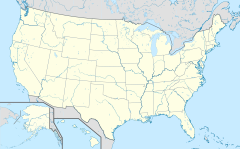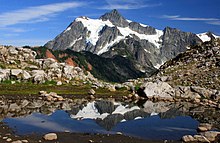North Cascades National Park
| North Cascades National Park | ||
|---|---|---|
| Diablo Lake in Ross Lake NRA between the north and south of the national park, view in south-west direction | ||
|
|
||
| Location: | Washington , United States | |
| Next city: | Seattle | |
| Surface: | 2,042.78 km² | |
| Founding: | 2nd October 1968 | |
| Visitors: | 30,085 (2018) | |
| Address: | North Cascades National Park | |
The North Cascades National Park in the north of the US state of Washington on the border with Canada covers more than 2040 square kilometers in the high mountains of the eponymous Cascade Range , a mountain range of volcanic origin. Only the high altitudes belong to the national park , which is almost unaffected by humans , the valley of the Skagit River with its three reservoirs is designated as Ross Lake National Recreation Area and divides the national park into a northern and a southern part. In the south, the park merges into the Lake Chelan National Recreation Area . Both National Recreation Areas are administered together with the National Park by the National Park Service . There is only tourist and other infrastructure in the National Recreation Areas, the national park is not developed. As such, it is the least-visited national park in the United States outside of Alaska.
The park was dedicated in 1968 , and since 1988 its area has also been designated as a Wilderness Area , the strictest class of nature reserves in the USA.
geography
The park is about 50 km east of Puget Sound and about 150 km northeast of Seattle . It has a completely high mountain character. Its highest point is the Goode Mountain with 2806 m in the southern part of the park. The park is accessed through Washington State Route 20 in the Skagit River valley . Some sections, especially the route over the Rainy Pass (1486 m above sea level) and the Washington Pass (1669 m above sea level), are usually closed in winter from November to April. The road is then buried under snow up to six meters high by avalanches. From the northwest, Washington State Route 542 leads to the Mount Baker Ski Area , from where hiking trails begin in the north of the national park, and in the southwest, the gravel road Cascade River Road extends to and into the park. From the south there is a ferry from Chelan on Lake Chelan to the north shore, from where you can hike into the national park.
The image of the mountains is characterized by over 300 glaciers, making the park the most heavily glaciated area in the United States outside of Alaska. The entire landscape shows the traces of glaciation in the Ice Age .
The national park is completely surrounded on the US side by the national forests of Mt. Baker – Snoqualmie National Forest and Okanogan National Forest . They are administered by the US Forest Service . Several wilderness areas and the Mt. Baker National Recreation Area are embedded in the national forests . On the Canadian border, the national park borders directly on the Skagit Valley Provincial Park and Manning Provincial Park in British Columbia .
geology
The northern cascade chain belongs to the older part of the mountain range and, unlike the southern part, is no longer primarily characterized by volcanism . There is no younger volcano in the national park itself, Mount Baker is a good 10 km to the west, Glacier Peak a little over 20 km south of the park, they both reach an altitude of over 3200 m. The mountains of the northern cascade range consist predominantly of metamorphic rock , mainly gneiss and slate , with intrusions of granite .
They came into being in two phases. The oldest parts arose from sediments that were deposited on the western edge of today's North American continent for up to four hundred million years . This happened through plate tectonic processes, during which island arches and sediments from the former seabed were pressed onto the continent. Massive pressure developed in the material, which led to the metamorphosis of the rock. The sedimentary rock was transformed into gneiss and shale. The northwest-southeast orientation of most mountain ranges comes from the impact of a small tectonic plate about 90 million years ago.
The Juan de Fuca plate began to hit the North American plate around 40–35 million years ago . A subduction zone formed and the melting material of the submerged Juan de Fuca plate triggered volcanism on the one hand and led to an uplift of the entire rock complex on the other . As a result, the erosion increased and the younger rock layers were removed. So do all the younger volcanoes in the park area. Therefore, the old, mostly metamorphic rock is exposed today.
The current appearance of the mountains is shaped by the massive glaciation in the Ice Age and to this day. The typical terrain structures are cirques and deep trough valleys , the striking Mount Shuksan in the northwest of the park is a karling , created by several glaciers that start from its flanks and have ground it to a pyramid-shaped tip with sharp ridges. The strong glaciation is the result of the location on the western flank of the cascade chain, which results in particularly high precipitation.
The central valley of the Skagit River has only been carved out as a trough valley by two independent glaciers in the east and west. The middle section, for example between Newhalem and the Ross Dam, is a notched valley dug by the river itself , which today has largely sunk in the reservoir. Lake Chelan in the south is a classic tongue pool lake .
Flora and fauna
Giant arborvitae and West American hemlocks grow mainly in the moister western valleys, rocky mountain firs, disheveled by the wind, form the transition to the subalpine meadows . More than 1500 plant species have been identified within the three areas of the National Park System, as well as hundreds of birds, reptiles, amphibians and thousands of insects. Bears, wolves, cougars and hawks are not very numerous but add to the genetic richness of this area. Between Newhalem and the border of Ross Lake National Recreation Area at Bacon Creek, bald eagles can often be seen feeding on salmon in mid-winter along the Skagit River .
history
The North Cascades region was not explored by white explorers until the 19th century. The fur trader Alexander Ross is said to have been the first white man to have traveled to the region. From 1880 to 1910 miners mined for gold, lead, zinc and platinum. They reported a moderate yield, but transportation was so laborious and profit so low that mining was abandoned. The first settlers and woodcutters came to the region around 1900. It was recognized early that the Skagit River could provide electricity, and between 1924 and 1961 the Seattle City Light electricity company built three hydroelectric dams along the Skagit River, which today supply about a quarter of Seattle's electricity needs. On October 2, 1968, North Cascades National Park, Ross Lake National Recreation Area, and Lake Chelan National Recreation Area were established. In 1988, about 93 percent of these three areas were designated by Congress under the name Stephen Mather Wilderness as Wilderness Area in order to preserve their wilderness character permanently.
activities
Almost the entire national park is designated as a wilderness area, so there are only a few facilities within the park. The national park has a visitor center at Newhalem, which is open daily from spring to autumn and on weekends in winter. It offers information and exhibitions on natural and cultural history as well as audiovisual and ranger- led programs and short hiking trails. There are no user fees for the North Cascades National Park.
Hiking and mountaineering are the most popular activities in the national park. In total, the protected area offers over 580 kilometers of hiking trails on which you can roam all habitats in mostly multi-day hikes. The Pacific Crest Trail also crosses the Stehekin River valley in the south of the park.
Seattle City Light offers regular tours of the Diablo Lake and Ross Lake dams. The reservoirs also serve as waterways that lead into the remote parts of these three National Park Service areas. Boats and motor boats can be rented from providers in the National Recreation Area.
literature
- Wolfgang Bittmann, Brigitte Fugger: Travel Guide Nature USA . Munich: BLV Verlagsgesellschaft, 1992. ISBN 978-3-7632-4067-8
- Saul Weisberg: North Cascades , KC Publications, Las Vegas, 1993, ISBN 0-88714-021-1
Web links
- National Park Service: North Cascades National Park (official site; English)
- US National Parks Net: North Cascades National Park (English)
- Description of the National Park Service (German)
Individual evidence
- ^ National Park Service: North Cascades National Park Service Complex - Natural Features & Ecosystems
- ^ National Park Service: North Cascades National Park Service Complex - Glaciers / Glacial Features
- ↑ Unless otherwise stated, this chapter refers to United States Geological Survey: Geology in the Parks - North Cascades
- ^ Weisberg, page 10
- ↑ Weisberg, pages 10-17




